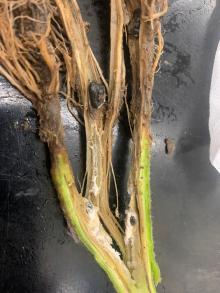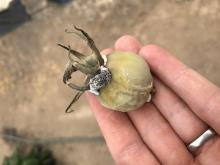Cause A fungus, Sclerotinia sclerotiorum, that attacks numerous other hosts and overwinters as hard, black sclerotia in soil and plant debris. The fungus colonizes any organic debris such as old leaves, stems or blossoms. Usually it grows from these materials into the healthy parts of the tomato. High humidity and free moisture favor infection.
Symptoms First, a rapidly expanding soft rot centers on a piece of organic material such as decaying leaves and flower petals. Stems may be girdled, killing the plant portions above the lesion. Affected stems turn light tan to a straw color and, under moist conditions, are covered with white cottony mycelium. Hard, black, irregularly shaped sclerotia less than 0.25 inch to almost 1 inch long develop in the mycelium and within the stem tissue. Fruit may be infected; if so, it looks gray and develops a watery rot.
Cultural control
- Space plants so the lower canopy dries out between irrigations.
- Limit overhead irrigation to only that necessary for crop production. A few deep irrigations are better than frequent shallow ones.
- In smaller plantings, remove infected material to reduce the sclerotia population in the soil.
- Use long rotations (3 to 4 years) with cereal crops.
Chemical control
- Problad Verde (Group BM01) at 20.5 to 45.7 fl oz/A on 7- to 10-day intervals. Needs 8 to 12 hours dry time to absorb into treated tissue. Do not make more than two (2) sequential applications before rotating to a labeled fungicide with a different mode of action. Preharvest interval is 1 day. Reentry interval is 4 hr. O



